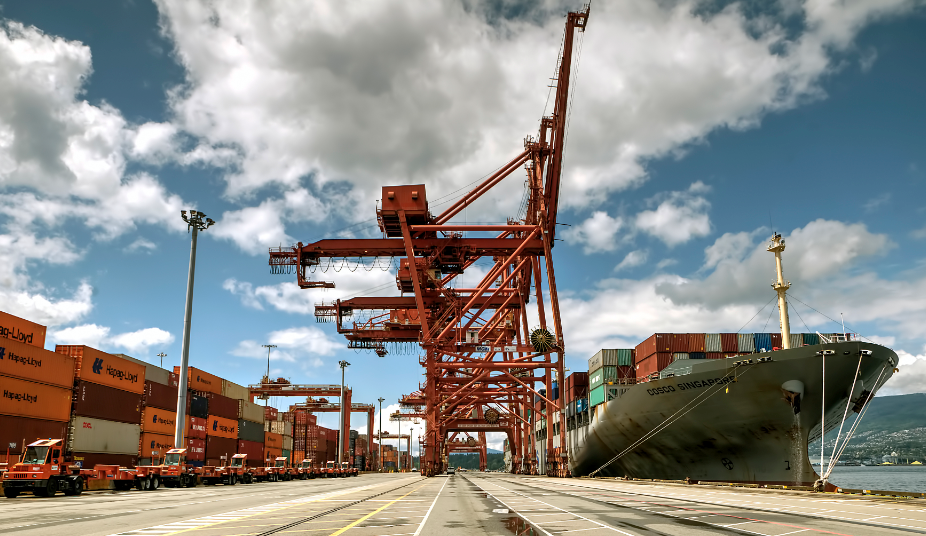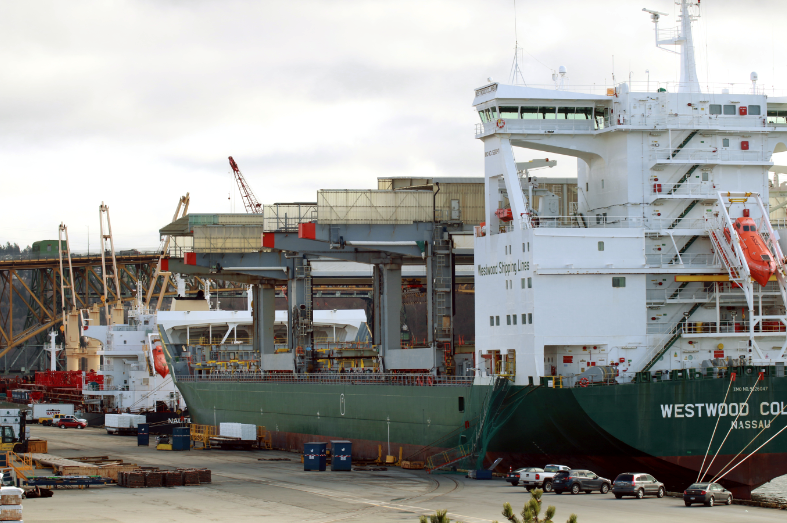Uneven Port of Vancouver cargo numbers for 2016 released last week reflect a flatlining global economy ahead and a tumultuous year past for major shipping lines.
But the port’s resilience in the face of economic volatility and its recognition in a new report as a fast-rising international shipping centre took much of the negative edge off those numbers.
The port’s overall 2016 cargo volume was down 1.8% to 136 million tonnes compared with 2015.
But Robin Silvester, president and chief executive officer of the Vancouver Fraser Port Authority, pointed out that, despite global economic downturns, the port’s ability to handle a wide range of imports and exports has helped it record its fourth consecutive year of cargo volumes of more than 135 million tonnes.
Other aspects of Vancouver’s port operations and regulatory environment are also highlighted in Deloitte’s EU Shipping Competitiveness Study.
The international benchmark analysis, released in late February, was commissioned by the European Community Shipowners’ Associations to provide data on the looming competitive threats to the European Union’s ports and to provide recommendations on how to retain and expand market share.
Vancouver is one of five “leading international shipping centres” used in the report’s comparative benchmarking analysis. Singapore, Hong Kong, Dubai and Shanghai are the others.
The report noted that, while most of the five still have minor global market share relative to the EU, “they experience high growth rates and are named the main competitors to the EU for location of strategic, commercial and operational shipping activities.”
Vancouver scored well in the report’s regulatory, economic and political factors category.
However, it still lags behind other shipping centres in availability of finance and is even further behind when it comes to local access to the legal, finance, logistics, insurance, brokering, chartering and professional services that are critical to success in the complex business of international shipping and cargo handling.
The federally and provincially funded Vancouver International Maritime Centre (VIMC) is focused on helping fill that void by promoting B.C. to the international shipping sector as a maritime centre and selling the advantages of basing shipping industry companies in Metro Vancouver, especially those in the sector’s lucrative and high-paying service arena.

Kaity Arsoniadis-Stein, VIMC’s executive director, said the Deloitte report will help the organization’s mandate because it gives Vancouver top scores in critical areas that make it a good place from which to conduct shipping industry business: taxation and other fiscal incentives; regulatory, economic and political factors; and ease of doing business.
But Arsoniadis-Stein said improvements are needed in several areas to increase the attraction of Vancouver and the rest of B.C. to major shipping industry companies.
For example, immigration complications, especially for top executives, need to be eliminated if the region hopes to attract more head offices.
Arsoniadis-Stein added that, while “Canada has some of the strongest banks in the world, none of them have international shipping expertise, and therefore there is no availability of ship finance. This is a big weakness. Shipping is a capital-intensive industry sector that requires significant investment.”
Some of the global shipping industry companies that have major offices in Metro Vancouver now include Seaspan Corp. (NYSE:SSW), Teekay Corp. (NYSE:TK), Pacific Basin Shipping Ltd. (HKG:2343), Mediterranean Shipping Co. and Methanex Corp.’s (TSX:MX) Waterfront Shipping Co. Ltd.
Grain, meanwhile, was among the Port of Vancouver’s good-news stories from 2016. Exports through the port were up 1.3% from 2015, reflecting strong global demand and a bumper harvest in Canada.
But a 22% drop in break-bulk lumber and wood pulp dragged down break-bulk cargo, which overall was down 1.4%, as was bulk dry cargo (-2.9%).
Containerized cargo was a mixed bag. While exports were up 3.3% to 1.1 million 20-foot equivalent units (TEUs), overall container cargo handled through the port was down 4.1% to 2.9 million TEUs compared with 2015.
The port’s year-end 2016 numbers continued the trend set in the year’s first six months when total cargo shipped through the port dropped 5.9% to 66 million tonnes compared with the same period in 2015.
Container traffic, which has grown steadily through West Coast B.C. ports over the past five years, especially in 2015, was also down significantly (6.5%) in the year’s first six months.
The drop in container traffic, in part, reflects the cargo boom in 2015 when major deep-sea container shipping companies diverted large numbers of U.S.-bound containers to West Coast Canadian ports because of goods movement interruptions caused by protracted dock worker contract negotiations at West Coast U.S. ports.
The Port of Vancouver’s numbers also mirror a slowdown in global economic growth, which worsened an already difficult year for global shipping lines. The companies, faced with overcapacity and record-low freight rates on major cargo routes, are in an industry that has lost more than US$50 billion in sales since 2014.

The outlook for 2017 is less dire than the realities of 2016.
However, the global forecast for container traffic remains far more subdued than earlier in the decade.
“Clearly there is more protectionist rhetoric around the world than there was a year ago,” said Silvester, “and that is a bit of a concern for all of us from an economic point of view.”
During a January 24 webinar on global container ports and terminals, Neil Dekker, director of container research at U.K.-based shipping consultancy Drewry, noted that the world economy is moving into a new era of “fairly low global growth.” That growth in 2015, he said, was around 1.3%.
“Our latest assessment for 2016 is about the same, so the days of 4%, 5%, 6%, 7% global growth are long gone.”
Dekker said Drewry’s outlook of relatively static container shipping growth extends to 2020.
But he added that the more immediate horizon for 2017 was somewhat brighter with global growth forecast at around 2.1% and growth on the transpacific trade route of approximately 3.2% in 2016 and the same or slightly less for 2017.
Dekker said 2016, an extremely tumultuous year for container shipping, was notable in a number of ways, including the increase in vessel scrapping aimed at reducing the container shipping sector’s overcapacity. An estimated 670,000 TEUs of capacity was scrapped during the year. That, Dekker said, helped bring supply and demand in tune with the overall global level for the “first time in many years.”
Reasons for optimism in the container shipping sector outlined in the webinar included stronger demand, higher fuel prices and what Drewry described as a “more disciplined commercial approach that carriers are taking.”
But the addition of 82 new and bigger container ships to major container fleets in 2017-18 will largely offset that capacity reduction.
Alphaliner noted in a January 18-24 newsletter that deliveries of new vessels will outpace scrapping by a 2-1 margin in 2017.
The global container shipping data company said that 78% of the 1.69 million TEUs of new capacity will be concentrated in ships of more than 10,000 TEUs.
Container carrier shipping lines collectively lost US$1 billion in 2016’s third quarter alone, and Drewry estimates the sector will finish the fiscal year with a US$5 billion loss.
In its 2016 annual report, Denmark’s Maersk Line (CPH:MAERSK-B), the world’s biggest container shipping company, posted a US$384 million loss compared with a US$1.3 billion profit in 2015. The company blamed poor market conditions that seriously eroded container shipping rates as one of the main reasons for the loss.
Depressed container rates coupled with the 2016 collapse of Hanjin Shipping have also hurt assorted suppliers to the industry, including Seaspan. The world’s largest independent container ship lease company has one of its four main global offices in Vancouver.
Dekker noted that vessels chartered to the now-bankrupt Hanjin were on long-term charter rates of between US$35,000 and US$45,000 per day, “which is fantastic when Gerry Wang [Seaspan CEO] signed those deals, but those ships have been returned and now Seaspan is [looking at] rates of US$8,000 and US$9,000.”
He added that demand for container ship charters is weak, “and there is a genuine oversupply in most key trades with plenty of tonnage to charter. … Operators are focusing on deploying their own tonnage and returning unwanted chartered tonnage.”
Drewry has since reported that Seaspan and other ship charter companies have found replacement lessees for 30 of 98 Hanjin ships.

Seaspan also bought four Hanjin ships for an estimated US$20.8 million.
Seaspan’s 2016 financials, released February 28, note that the company absorbed US$19.7 million in expenses from the Hanjin bankruptcy. While Seaspan’s fiscal 2016 revenue rose 7.2% to US$878 million compared with US$819 million in 2015, it reported a US$139 million loss compared with a US$199 million profit in 2015.
Seaspan is not the only shipping industry company facing financial writeoffs in the wake of Hanjin’s collapse.
Alphaliner noted that it has left a lengthy debt trail: Hanjin’s last published financial report (September 30, 2016) listed liabilities of US$6.06 billion against assets of US$3.93 billion.
The rate of recovery for unsecured creditors, Alphaliner said, “is expected to be close to zero,” because most of Hanjin’s unencumbered assets “are being sold at very low prices.”
In another area of global shipping, Teekay reported a net loss of US$123.1 million in 2016 compared with profit of US$82.15 million in 2015.
The marine energy transportation company, which provides ship charters and other services in the global oil and liquefied natural gas sectors, has consolidated assets of approximately US$13 billion.
Teekay’s 2016 revenue, according to its most recent corporate financials, was affected by a number of issues, including lower ship charter rates.
But analysts see sunny breaks on the 2017 horizon.
Drewry’s outlook for a somewhat brighter 2017 is shared by the National Retail Federation. The U.S.-based organization’s latest Global Port Tracker projected a 4.6% increase in imports to U.S. major retail container ports during the year’s first half.
The federation noted that ports covered by the tracker handled 10.2% more cargo in December 2016 compared with the same month in 2015 and 6.6% more in January 2017 than in January 2016.
Maersk Line is also more bullish on the year ahead.
Its outlook for 2017, based on a forecast of global container shipping growing between 2% and 4%, is a profit of more than US$1 billion compared with its US$384 million loss in 2016.
Silvester noted that private-sector investment in port infrastructure, like G3 Global Holdings’ new $500 million grain terminal on the port’s north shore and DP World’s planned $350 million expansion of its Centerm container terminal on the south shore of Vancouver’s inner harbour, is creating new capacity in the port.
That shows, he said, “that all those businesses have confidence in the long-term growth potential that we have here, and that is good for Vancouver’s economy.”
[email protected]



